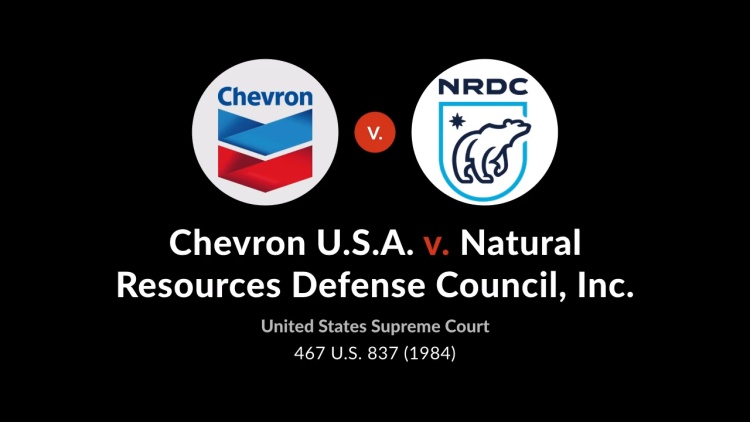Legal Precedents and Arguments

Chevron vs nrdc overturned – The Chevron vs. NRDC case established the legal basis for judicial review of agency interpretations of statutes. The case arose from a dispute over the Environmental Protection Agency’s (EPA) interpretation of the Clean Air Act.
Chevron vs. NRDC overturned has stirred legal waters, with implications rippling far beyond the courtroom. The Grants Pass Supreme Court ruling has reverberated throughout the legal community, prompting discussions about the scope of judicial review and the balance of power between the courts and agencies.
As the dust settles, it remains to be seen how this decision will shape the future of environmental law and beyond.
The NRDC argued that the EPA’s interpretation was unreasonable and inconsistent with the statute’s text. Chevron argued that its interpretation was reasonable and entitled to deference from the courts.
Supreme Court Decision
The Supreme Court ruled in favor of Chevron, holding that courts must defer to agency interpretations of statutes if they are reasonable. This decision established the “Chevron deference” doctrine, which has been applied in numerous cases since.
Implications for Environmental Policy: Chevron Vs Nrdc Overturned

The Chevron decision has had a significant impact on environmental regulation in the United States. By deferring to agency interpretations of ambiguous statutes, the Court has made it more difficult for environmental groups to challenge agency actions in court.
One specific example of how the Chevron decision has influenced policymaking is the Environmental Protection Agency’s (EPA) regulation of greenhouse gases. In 2007, the Supreme Court ruled in Massachusetts v. EPA that the EPA had the authority to regulate greenhouse gases under the Clean Air Act. However, the Court also noted that the EPA’s interpretation of the Clean Air Act was entitled to Chevron deference. This meant that the EPA’s decision to regulate greenhouse gases was very difficult to challenge in court.
The Chevron decision has also had implications for future environmental protection efforts. By making it more difficult to challenge agency actions in court, the decision has made it easier for agencies to adopt pro-industry policies. This could have a negative impact on environmental protection in the long term.
Criticisms and Alternatives

The Chevron decision has been criticized on several grounds. First, critics argue that it gives too much deference to agencies, allowing them to interpret statutes in ways that are inconsistent with the intent of Congress. Second, critics argue that Chevron undermines the role of the judiciary in reviewing agency decisions. Third, critics argue that Chevron makes it difficult for citizens to challenge agency actions.
In response to these criticisms, several alternative approaches to judicial review of agency decisions have been proposed. One approach, known as the “hard look” doctrine, requires courts to take a close look at the agency’s decision-making process to ensure that it was rational and supported by the evidence. Another approach, known as the “arbitrary and capricious” standard, requires courts to determine whether the agency’s decision was arbitrary, capricious, or an abuse of discretion.
Each of these alternative approaches has its own advantages and disadvantages. The “hard look” doctrine is more deferential to agencies than the “arbitrary and capricious” standard, but it also requires courts to conduct a more thorough review of the agency’s decision-making process. The “arbitrary and capricious” standard is less deferential to agencies than the “hard look” doctrine, but it also gives courts more discretion in reviewing agency decisions.
The Textualist Approach, Chevron vs nrdc overturned
The textualist approach to judicial review of agency decisions focuses on the plain meaning of the statute that the agency is interpreting. Under this approach, courts are not permitted to defer to an agency’s interpretation of a statute if that interpretation is inconsistent with the plain meaning of the statute.
The textualist approach has several advantages. First, it is consistent with the principle of separation of powers. Under the separation of powers doctrine, the judiciary is responsible for interpreting the law, while the executive branch is responsible for enforcing the law. The textualist approach ensures that the judiciary retains its role as the final arbiter of the meaning of the law.
Second, the textualist approach is more likely to produce consistent and predictable outcomes. When courts are required to focus on the plain meaning of the statute, they are less likely to be influenced by their own policy preferences or the arguments of the parties.
However, the textualist approach also has some disadvantages. First, it can be difficult to determine the plain meaning of a statute. Statutes are often complex and ambiguous, and there may be multiple reasonable interpretations of a particular statute.
Second, the textualist approach can lead to results that are inconsistent with the intent of Congress. In some cases, the plain meaning of a statute may not reflect the actual intent of Congress. This can occur when the statute is poorly drafted or when Congress has changed its mind about the meaning of the statute since it was enacted.
The Chevron vs. NRDC case, a landmark environmental ruling, was overturned in 2020. This decision has significant implications for the interpretation of environmental laws, as it limits the deference given to agency interpretations. To understand the implications of this ruling, it is crucial to delve into the chevron overturned meaning.
By examining the legal principles behind the Chevron doctrine and its recent reversal, we can gain insights into the evolving landscape of environmental regulation and the role of the courts in interpreting complex statutes.
In a landmark ruling, the Supreme Court has overturned the Chevron vs. NRDC precedent, a decision that had granted deference to federal agencies’ interpretations of ambiguous statutes. This decision, known as scotus overturns chevron , has significant implications for the balance of power between the courts and federal agencies, and is likely to have a major impact on future environmental and regulatory cases.
Chevron v. NRDC was overturned in 2022, marking a significant shift in the interpretation of the Chevron doctrine. To understand the implications of this ruling, it’s essential to delve into the chevron ruling explained. The Chevron doctrine, established in 1984, gave deference to agencies’ interpretations of ambiguous statutes.
However, the overturning of Chevron v. NRDC now requires courts to exercise independent judgment when reviewing agency actions, thus limiting the scope of deference granted to agencies.
The recent overturning of Chevron v. NRDC has sparked a debate about the role of the Supreme Court in environmental law. As the Chevron decision had previously given great deference to agencies’ interpretations of environmental statutes, its reversal raises questions about the future of environmental regulation.
It remains to be seen how the Court’s new approach will impact the balance between environmental protection and economic development in the years to come.